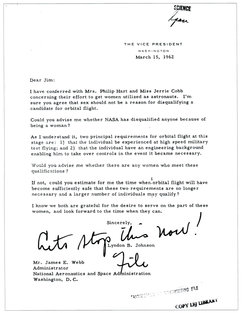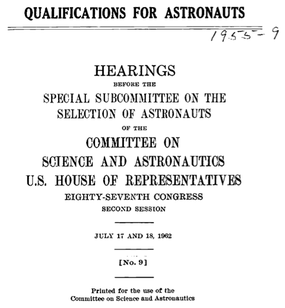"Lets Stop This Now"

Source: Almost Astronauts, Tanya Lee Stone
In the 1960's while the cold war raged through fields of space and science, women were looking join the fight. Despite the efforts of women such as Jerrie Cobb and Jane Hart, women were not allowed to become astronauts. One such effort lead them to the desk of Liz Carpenter, Vice President Johnson's executive secretary. Carpenter drafted a letter to James Webb, director of NASA. Upon showing the letter to Vice President Johnson in March of 1962, he wrote "Lets Stop This Now".

On July 17th and 18th of 1962, the House of Representatives Committee on Aeronautical and Space Science met to discuss the qualifications of astronauts. At the subcommittee hearing, the Mercury 13, a group of female astronaut candidates were disregarded due to a lack of experience as test pilots. Conveniently, for those in charge of NASA, women could not participate in testing jet aircraft as only male Air Force service pilots were allowed this opportunity. After continued pressure for equal rights for women, in 1964, the Civil Rights Act was signed by President Johnson. In 1967, President Johnson signed the Executive Order 11375, beginning affirmative action to ensure women and minorities equal opportunities as white males employed at federal agencies.
In the 1970s the Military began allowing women to enter their program (Public Law 94-106), and participate in testing jet aircrafts. Nearly 16 years after the Senate Committee hearing on the qualifications for astronauts, NASA finally allowed for the recruitment of women astronauts (1978).

